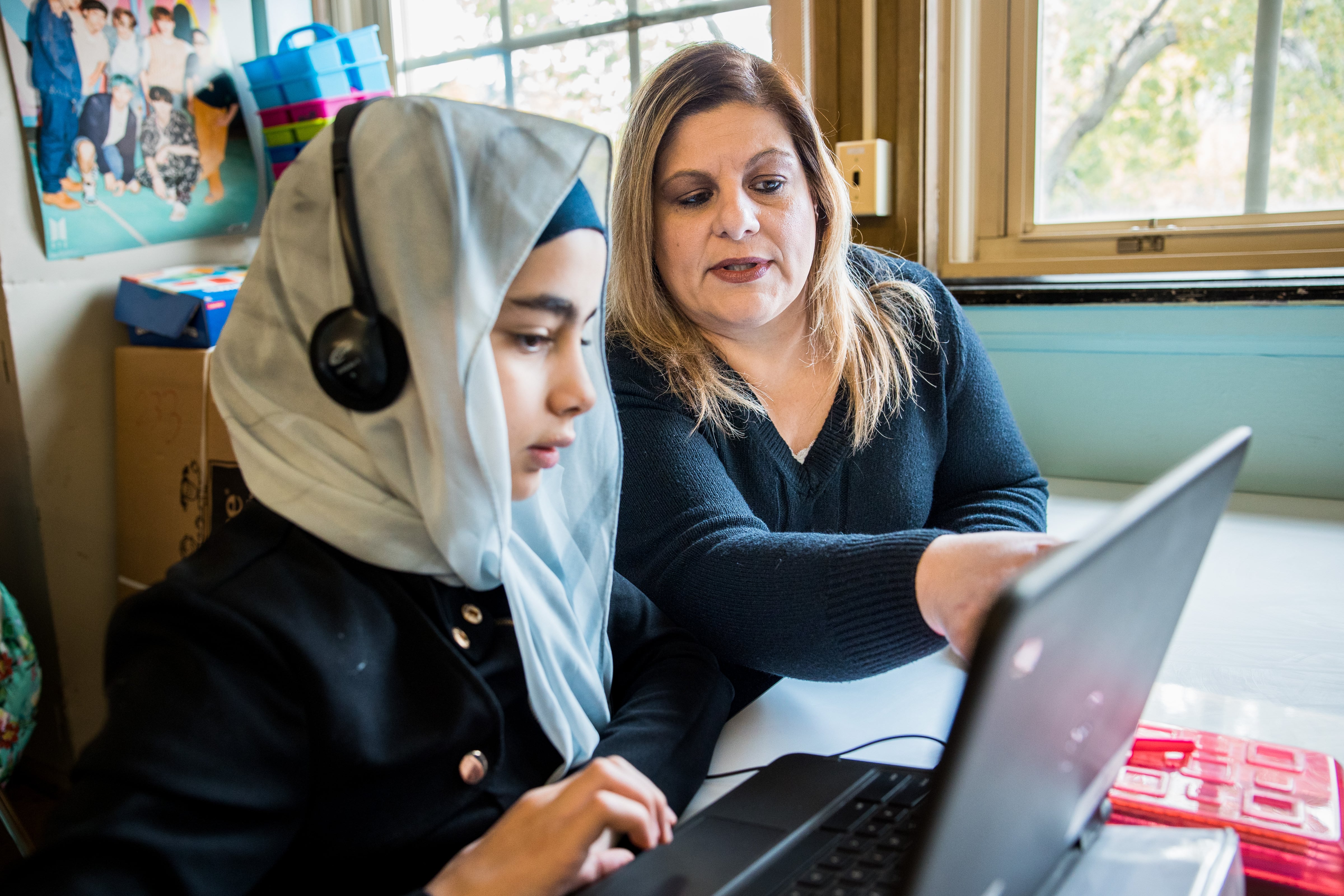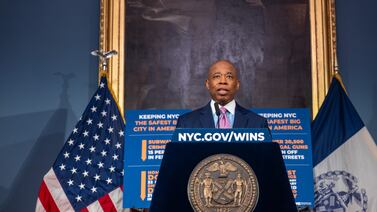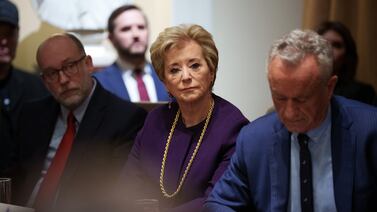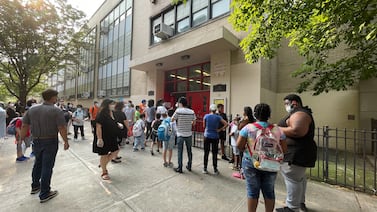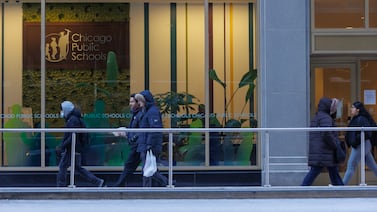Sign up for Chalkbeat’s free monthly newsletter How I Teach to get inspiration, news, and advice for — and from — educators.
When Maureen Delgado walked into her first classroom at Clinton Elementary in 1999 to teach middle school English and Social Studies, it was virtually empty — no textbooks, no pens, nothing.
“If I hadn’t had experience previously teaching, I probably would have really struggled,” Delgado said. “But that’s also one of the things that I think about when I hire new teachers: How can I support them? How can I make sure that they have what they need?”
Delgado is now the principal at Clinton, a kindergarten through eighth grade school in Chicago’s West Ridge neighborhood on the city’s north side. It’s a role she took on in 2016 after several years as the school’s assistant principal.
This month, Delgado and a handful of Chicago Public Schools principals are being featured on Chicago Transit Authority buses and trains as part of Principal Appreciation Month. District officials said she was chosen for creating an inclusive environment for Clinton’s immigrant and refugee population.
Delgado spoke with Chalkbeat Chicago about how she leads one of the city’s largest elementary schools, serving more than 1,000 students, 90 percent of whom are from low-income households and 62 percent of whom are English learners.
This interview has been lightly edited for length and clarity.
What made you want to be a principal?
I think if you were to ask me, back when I was doing my undergrad work, I would say I just wanted to be a teacher, and that’s all I wanted to do. But through my experiences here, I found myself being pushed into leadership roles, such as a grade-level instructional team leader. I think one of the things that really propelled me, though, was I realized that the opportunities and structures I had set up in my classroom were not necessarily the same across the school. I thought I could do more good as a school leader in order to support all of our learners.
Tell me a little bit about your own experience with school growing up and how it affects your work today.
My own experience in school is kind of embedded in working in this neighborhood. My father was an immigrant from the Middle East. My mother was a second-generation American. School was always important. I was the first person in my family to go to college. There were no ifs, ands, or buts in our family. You were going to get a college degree. It was always ingrained in us that school is important, that we’re here in this country being given the opportunity to better ourselves. My father felt that education was really the driver to seek a better life, and he was a proponent of making sure that that happened for his family.
I always wanted to be a teacher. I tortured my family, my cousins by playing school on the weekends. I had a chalkboard that I was given as a birthday gift. I just was always really drawn to education and drawn to helping kids and to helping students learn. When I was attending school at nearby Rogers Elementary, I spent a lot of time volunteering in younger grades like kindergarten and first grade. I’d spend my lunch periods or other free periods helping out in those classrooms. In high school, there was a child development class and we had a preschool in our high school, where I would volunteer. At Clinton, I feel like I found my niche and I found the perfect community to do that in.
Chicago has seen a big influx of migrant students. How is your school helping newcomer students?
One of the things that has drawn me to this community and has helped me stay here is being a child of an immigrant myself. My family comes from the Middle East and my aunts’ education stopped at what would be the equivalent of third or fourth grade. They never felt like they could go into their children’s school. So they relied on my mother who was English-speaking to be able to advocate for my cousins because they just never felt welcome in the school and they felt that that barrier would hinder them.
West Ridge and Rogers Park is a very diverse part of the city and it’s been diverse for years. Clinton is right off of Devon Avenue, which is known as Little India. We’ve had a lot of Asian families from Pakistan and India, but we also have a lot of different families from the Middle East. When I was teaching, we would get a lot of families from Eastern Europe, especially Kosovo, Bosnia, when there was a civil war there. We’ve always been welcoming different immigrants and different refugees from around the world.
We’ve continued to do that at Clinton. What has been a little bit more challenging this year is that we’ve had over 115 kids that have enrolled as newcomers since the beginning of the school year. We do have a lot of support in place, but it’s just been very fast. And while about a quarter of them are Spanish speaking, there’s another quarter that are Arabic speaking. We also have students that speak Rohingya, Burmese, Somali. We have 45 different languages spoken here. Our issues have been, ‘How do we support this huge influx that we’ve gotten?’ Because we’re also expecting more.
Over the last few years, our teachers have gotten English as a Second Language endorsements. About 95% of our teachers have their ESL endorsements. One of the things we focused on, particularly last year, was doing a professional learning community with those teachers. We have our English Language Program teachers who work as coaches and so they go in and support teachers.
We also have a lot of teachers that speak another language. Whenever we have parent meetings or one-on-one meetings about a student’s progress, we make sure that if we don’t have somebody on staff who speaks that language, we utilize the language line [a hotline we can call to get a translator]. So that helps us strengthen that home-to-school connection.
What’s the best advice you’ve ever received and how have you put it into action?
I think the best advice I’ve ever received is to really listen. One of the things that I’ve had to do as an administrator is really to listen to my community, our school community, and kind of hear what we’re struggling with and being able to have people express their concerns or question things. That has really helped to guide where we’re headed as a school and to guide our new instructional shifts and our focus is just really being able to listen to the community.
I think a lot of times people are always thinking about how to respond to something or about how they’re gonna get their point across. But I think for me, just really taking the time to listen and process what I’ve been told.
How has your school worked to support students’ mental health?
One of the things that we’ve always offered here is a partnership with Asian Human Services, now known as Trellus, so we’ve always been able to offer counseling within the school day, which I think really helps some parents become more comfortable with the idea [of counseling] because they trust the school.
Thankfully, the district has given us a second counselor. That has been phenomenal for our school. We have a rainbows group that’s meeting about loss. We have a positive minds group that’s talking about self esteem and really growth mindset. We have a wellness group that’s talking about wellness, holistically, not just physical wellness, but also mental health. We have different “lunch bunches” where kids are able to meet and have lunch with the counselor and talk about things very organically.
In addition, our counselors are supporting our teachers, with programs such as Second Step and Calm Classroom. We’re also working on restorative practices within our school.
All of that has helped to make parents more comfortable so that when we have students who do require some additional support, they trust us. We also do workshops on mental health with our Parent Advisory Council.
How do you take care of yourself when you’re not at work?
If you ask my family, they’ll say I’m never not at work. Even if I’m not physically in the building, my mind is constantly thinking about school. But I think the way I take care of myself is really spending time with family and friends and taking care of my own mental health. Sometimes it’s getting a massage, sometimes it’s reading, sometimes it’s vegging out on Netflix.
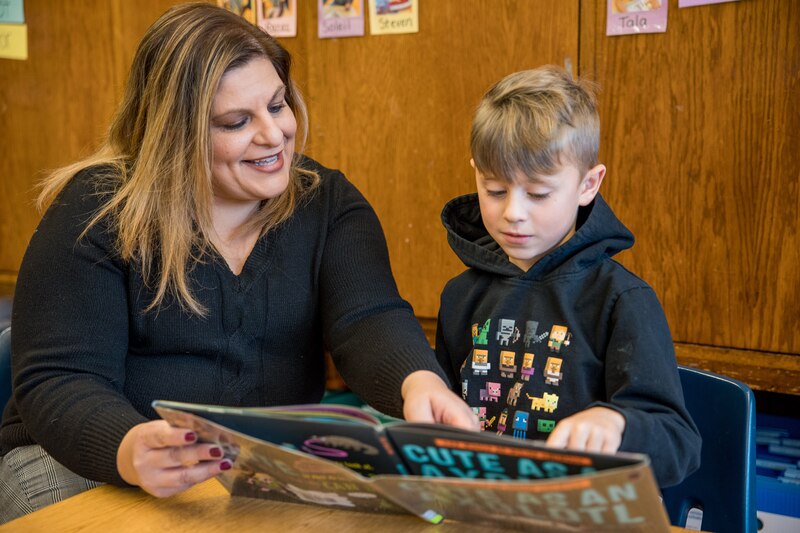
How does it feel to have pictures of yourself on Chicago Transit Authority buses and trains?
I haven’t physically seen one yet, but I know one of my clinicians did. I will say, I am really committed to this school and this community. I am really proud of the work that we’re doing. And I’m very proud of the teachers, our students, our staff, and our parents. Whatever I can do to share that I’m more than willing to do it.
My father passed away a few years ago and I was telling my mom about it and I said, ‘You know what, I think he would have been proud of me.’ And she goes, ‘Yes, he would be so proud of you.’ On a personal level, it’s kind of nice to know that I’m being recognized. But in terms of the school, I’m happy that we’re being recognized. Our goal is to be the best neighborhood school in the city of Chicago, and I think we’re on our way to doing that.
Becky Vevea is the bureau chief for Chalkbeat Chicago. Contact Becky at bvevea@chalkbeat.org.

